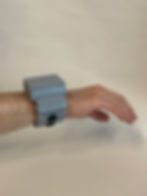Why Haptics?
- Chaya O'Grady
- Jul 15
- 3 min read
Sensory Substitution: Communication through touch

Touch has a Direct connection to the Brain
The body is equipped with 5 (five) sensory organs: sight, smell, hearing, taste, and touch. While there are individuals who have all five of these senses intact, there are over 285 million who are blind, have low vision, or are deafblind. For these individuals, they rely on their remaining senses to interact with the world around them.
The sense of touch, otherwise known as haptics, utilizes the largest sensory organ on the human body, the skin. More importantly, the haptic system is comprised of several different receptors which operate in concert to receive information such as hot and cold, textures, pressure, and even where your body is in space. Consider this, without the haptic system, you would not be able to feed yourself, orient yourself in a room, walk, or even stand up right without assistance.
The kinesthetic haptic system is what tells your muscles, tendons, ligaments, bones, and even skin where they are in relation to each other as well as to other objects. Take, for example, a breeze blowing across your skin; to feel a breeze, it passively blows over your skin. Likewise, Braille is a combination of raised dots on a surface; however, when the fingertips actively pass over them, the displacement of the skin on the fingertips interprets these dots as words. Finally, knowing where your body is in space is critical for gross and fine motor skills, such as moving your hands to your mouth, putting clothes on, standing, and walking. The human body is comprised of a diverse set of haptic receptors, which are used every day, and have rapid communication with the brain.
We often think of touch as just physical contact, but in actuality, it’s deeply tied to cognition, emotion, and learning. This is why a proficient Braille reader can read over 500 words a minute, and why we believe haptic feedback can support communication during social interactions.
So you ask, Why Haptics?
For those who have access to the sense of sight, they rely on nonverbal cues—like hand gestures, body posture, or facial expressions—to interpret social interactions. But for people who are blind or have low vision, those cues can be difficult or impossible to access. That’s where haptics come in.
At HapWare, we believe haptics are one of the most powerful yet underutilized modalities targeted for assistive technology designed and developed for individuals who are blind, have low vision, or Deaf blind.
When Visual Cues Aren’t Accessible, Haptics Fill the Gap
Imagine someone smiles at you, gestures toward the door, or raises their eyebrows in surprise. If you can’t see their face or body language, those social signals are invisible, but with haptics, we are allowing our users the opportunity to feel visual information.
AlEye, our wearable haptic translator, detects nonverbal communication signals like facial expressions, hand gestures, and body language and translates them into dynamic, real-time, nonintrusive, and intuitive haptic patterns felt on the wrist. It’s a new kind of sensory input, not to replace vision, but to offer another way to engage with the world.
Why Haptics Work for Our Users
For many of our early testers who are blind or have low vision, haptics offers something unique:
Discretion. Vibrations are quiet and non-intrusive.
Clarity. Each pattern is simple, distinct, and intuitive
Confidence. There’s no second-guessing or missing cues. Just direct, real-time information.
After beta testing AlEye, one user said: “I didn’t realize how many reactions I was missing until I started to feel them. Now I know when someone’s engaged, surprised, or walking away—it makes conversations so much smoother.”
We're Just Getting Started
The sense of touch is underutilized in assistive technology, but it doesn’t have to be. At HapWare, we’re not just building tools, we’re building connections, and we believe haptic communication is a key to more inclusive, responsive, and human interactions.